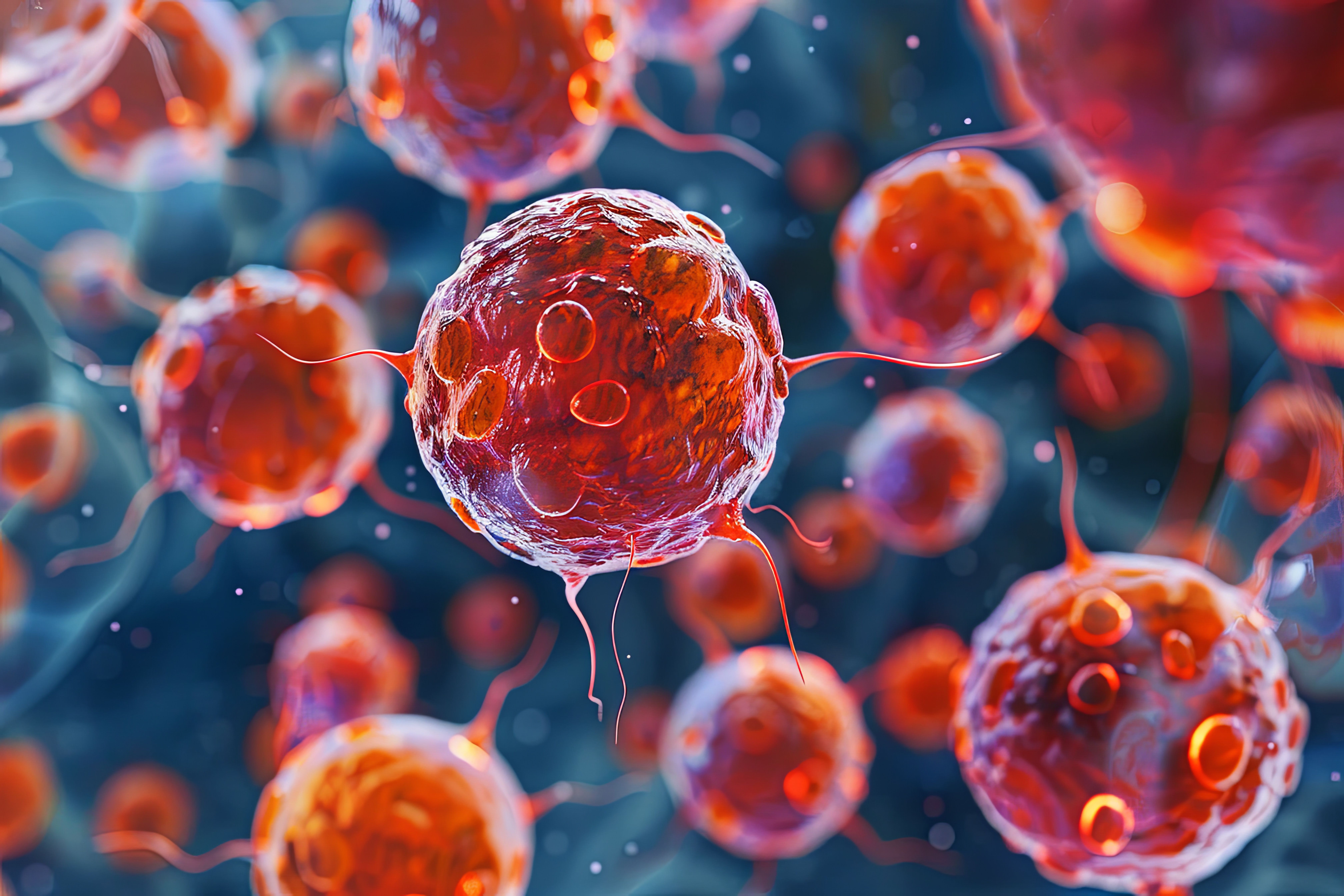- Center on Health Equity & Access
- Clinical
- Health Care Cost
- Health Care Delivery
- Insurance
- Policy
- Technology
- Value-Based Care
Study Reveals Leukemia Transplant Successes and Persistent Relapse Risks
Long-term survival rates for patients with leukemia after hematopoietic cell transplantation (HCT) are encouraging but personalized transplant strategies remain important to improve outcomes.
A new study examines the long-term outcomes of patients who survive at least 2 years after allogeneic hematopoietic cell transplantation (HCT). Published in HemaSphere, the study presents data from 11,728 patients who underwent HCT between 2005 and 2012, revealing a 10-year survival rate of 81.3% for patients with acute lymphoblastic leukemia (ALL) and 76.2% for patients with acute myeloid leukemia (AML).1
AML cells concept | image credit: sovova - stock.adobe.com

The study, conducted across multiple centers between 2005 and 2012, analyzed 2701 patients with ALL (median age = 34 years) and 9,027 patients with AML (median age = 48 years) who were alive and relapse-free 2 years after HCT. The majority of patients (78.6% for ALL and 68.6% for AML) were in first complete remission with undetectable measurable residual disease
(68.3% for ALL and 78.9% for AML).
The study also examined secondary endpoints, including relapse incidence, leukemia‐free survival (LFS), non‐relapse mortality (NRM), and chronic Graft-versus-host disease (cGVHD). According to the data, LFS was found to be 78.2% for patients with ALL and 72.3% for those with AML. Relapse remains the leading cause of late mortality, contributing to 33.9% of deaths in patients with ALL and 44.9% with AML. cGVHD is the second most common cause of death, accounting for 29% of mortality in ALL and 18% in AML, followed by infection, and secondary malignancy. The study reports that NRM at 10 years reached 16.8% for patients with ALL and 20.4% for those with AML.
In comparison, a study of 4485 patients who underwent HCT for hematologic malignancies between 1976 and 2014 found that while half of all deaths were due to the primary disease, this dropped to 10% among 15-year survivors.2 For these long-term survivors, late NRM was mainly caused by secondary malignancies (26.1%) and cardiopulmonary disease (20.2%). “In our study, one can speculate that the likelihood of death from other causes 10 years after HCT was minimal. Cardiac toxicity was not predominant, but there were 7.6% secondary cancers in ALL and 11.3% in AML,” the authors added.1
Donor type and patient age were identified as key prognostic factors for both leukemia types. The study found that transplants from unrelated donors in patients with ALL were linked to poorer outcomes, with a shorter OS (HR, 1.34;95% CI, 1-1.8; P =.047) and a higher incidence of NRM (HR, 1.67; 95% CI, 1.17-2.39, P = .005) compared to transplants from a matched sibling donor. Similarly, patients with AML who had unrelated donor transplants were linked to a higher incidence of NRM (HR, 1.28; 95% CI, 1.07-1.53; P = .008).
The results of the study also showed for each additional 10 years of age at transplant, overall survival decreased by 20% in patients with ALL (HR, 1.20; 95% CI, 1.08-1.33, P = .0005) and by 30% in patients with AML (HR, 1.30; 95% CI, 1.23–1.37; P < .0001). Increasing age was also linked to lower LFS, lower CR rates, and increased NRM.
The conditioning regimen used in transplantation influenced outcomes in patients with AML, but no significant survival differences were found in patients with ALL. Among patients with AML, reduced intensity conditioning (RIC) regimens were associated with an increase in OS (HR, 1.21; 95% CI, 1.06-1.37; P = .004) and LFS (HR, 1.15; 95% CI, 1.02-1.29; P = .021) and a lower incidence of cGVHD. However, the study found that NRM also increased with RIC (HR, 1.21; 95% CI, 1.01–1.44; P = .039). Furthermore, specific transplant characteristics, such as the use of peripheral blood stem cells over bone marrow grafts, were associated with inferior outcomes in both ALL (HR, 1.54; 95% CI, 1.11-2.14; P = .009) and AML (HR, 1.2; 95% CI, 1-1.43; P = .048).
Overall, this study highlights the successes and challenges in managing leukemia 2 years post-HCT. Allogeneic HCT has long been recognized as a curative therapy for acute leukemia, particularly for patients at high risk of disease relapse.3,4 Based on the study results, the authors propose, “Our study highlights the need to refine and optimize pretransplant strategies and integrate comprehensive survivorship programs to improve long‐term outcomes in acute leukemia patients undergoing HCT.”
References:
- Larue M, Labopin M, Schroeder T, et al. Long-term outcome of 2-year survivors after allogeneic hematopoietic cell transplantation for acute leukemia. HemaSphere. 2024;8. doi:10.1002/hem3.70026
- Bhatia S, Dai C, Landier W, et al. Trends in late mortality and life expectancy after allogeneic blood or marrow transplantation over 4 decades: a blood or marrow transplant survivor study report. JAMA Oncol. 2021;7(11):1626-1634. doi:10.1001/jamaoncol.2021.3676
- Magee G, Ragon BK. Allogeneic hematopoietic cell transplantation in acute myeloid leukemia. Best Pract Res Clin Haematol. 2023;36(2):101466. doi:10.1016/j.beha.2023.101466
- Gupta V, Tallman MS, Weisdorf DJ. Allogeneic hematopoietic cell transplantation for adults with acute myeloid leukemia: myths, controversies, and unknowns. Blood. 2011;117(8):2307-2318. doi:10.1182/blood-2010-10-265603
